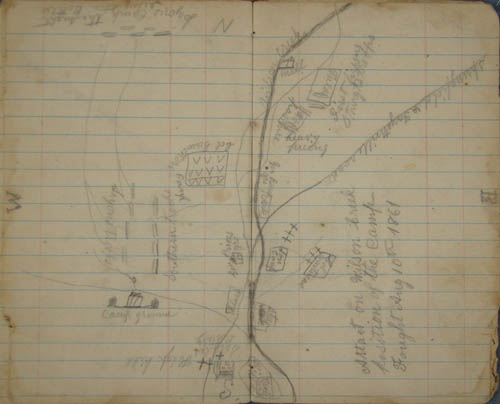Asbury C. Bradford Journal

Captain Asbury C. Bradford kept this journal of enrolled soldiers, equipment and actions of Company E, 2nd Regiment, 8th Division, Missouri State Guard. The 2nd Regiment was organized in July 1861, and Bradford recorded company notes and journal entries from August through November 1861.
The Eighth Division, under the command of Gen. James Rains, participated in the Battle of Wilson’s Creek on August 10, 1861. Wilson’s Creek was the second major battle of the Civil War. Union troops under Nathaniel Lyon marched from Springfield, Missouri to engage the Confederates encamped along the creek. Completely surprised by the attack, the Confederates were able to hold their ground and repel the Union advance. Gen. Lyon was killed during the battle, and Union forces retreated to Rolla, MO. Bradford sketched part of the battlefield noting the location of the Sharp house, Sterling Price’s headquarters at the Edwards’ farm and the Gibson’s Mill.
Bradford’s Map of Wilson’s CreekAfter the Battle, Bradford’s company marched north with Price and participated in the Battle of Lexington between September 18 and 20, 1861. Price mobilized roughly 7,000 men on his march to Lexington. The town was held by Col. James A. Mulligan and his force of 2,700 Federals. Southerners flocked to Price, and by September 18 his army had grown to nearly 10,000 men.
Mulligan fortified his position in the Masonic College on the north end of town. Rains and his men, which included 3,052 guardsmen and two batteries of artillery, took a position to the north and east of the college. Mulligan launched an unrelenting artillery barrage into the approaching Confederate line. The Rebels captured Oliver Anderson’s house, which at the time was being utilized as a Union hospital. This enraged Mulligan, and he quickly ordered a counterassault to reclaim the building. The order resulted in heavy casualties, and the Federals only held the Anderson home for a short period before the Confederates overpowered them again.
On September 19, the guardsmen encircled the college, and the federals eventually exhausted their supplies. The Union men, surrounded by enemy troops, were forced to endure the battle and heat without water. On September 20, the Confederates discovered a large quantity of hemp bales stored in a nearby warehouse. The guardsmen rolled the bales onto the battlefield slowly charging the Union trenches. The bales provided ample protection for the men; even the Union cannons could not penetrate the dense hemp. Finally, the guardsmen advanced close enough to charge the Union line. Hand-to-hand combat erupted, and soon Mulligan realized surrender was his only option. Price captured several pieces of artillery, 3,000 rifles and 750 horses.
In his journal, Bradford recorded the names of his men who fought bravely at Lexington. He then made a list of those who did not answer the call of duty.
The following list of names are those who stood bneath the enemies grape and muskets for 60 hours at Lexington Mo and won for themselves never dying glories
The following list of names are those who did not go to the brest works oposite these names are there and by excuses for them1
Price reported 25 killed and 72 wounded for the three day engagement. Rains reported only two men were killed from the 8th Division and twenty wounded. Bradford offered the following tribute to his fallen comrades.
So Sleep the brave who sink to res with all there countrys’ wishes best
While Confederate troops clinched victories at Carthage, Wilson’s Creek and Lexington, Governor Claiborne Fox Jackson prepared the political stage for Missouri admission to the Confederacy. The General Assembly elected to remain in the Union in early 1861, but Jackson was determined to cut ties with the United States Government. Days before the Battle of Wilson’s Creek, Jackson issued a “Proclamation of Independence,” which declared Missouri a sovereign and independent state. He cited atrocities committed by Union forces, who repeatedly violated Missouri’s rights and liberties. Two weeks later, the Confederate Congress passed a resolution admitting Missouri to the Confederacy, but technically Missouri had not seceded from the Union.
The momentum built from the victories on the battlefield gave Jackson the opportunity to achieve his goal. In September, Jackson called the General Assembly back into session, and asked them to meet at the Newton County Courthouse in Neosho on October 21. On October 20, Bradford’s men marched towards Neosho to protect the legislators as they gathered to solidify Missouri’s future with the Confederacy.
Sunday 20 marched to Neosho
Sunday 27 yet at Neos.
Monday 28 a fine day News confirmed that the Fedrals are in Springfield Also the Legislature in Neosho assembled ratified the Proclamation of the Govens delivered at Newmadrid
Bradford served in the Missouri State Guard for six months. On March 1, 1862, he was transferred to the 5th Missouri Infantry, C.S.A. According to his service records, Bradford participated in the Battles of Carthage, Wilson’s Creek, Dry Wood, Lexington, Pea Ridge, Fort Gibson, Champion Hill and Vicksburg. Bradford left the service on furlough in August 1863. His records state he was last heard from on December 22, 1863, when he reported that he was extremely sick and did not expect to live. Bradford resided in Bolivar, Missouri.
Contributed by Wilson’s Creek National Battlefield
- Asbury Bradford, Journal, 1861. WICR 30060. Wilson’s Creek National Battlefield, Republic, Missouri, 49-52.














